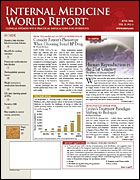Publication
Article
Internal Medicine World Report
Increase the Thyroxine Dose in Patients With Gastric Comorbidities
Author(s):
N Engl J Med
Absorption of thyroxine is key to its beneficial effects in patients with multinodular goiter. Now a study has demonstrated that gastritis reduces absorption, and thus the usual doses of thyroxine are probably inadequate for patients with both conditions (. 2006; 354: 1787-1795).
Helicobacter pylori–
Investigators recruited 248 patients with multinodular goiter; 53 also had related gastritis, and 60 also had atrophic gastritis. Measurements of serum levels of thyrotropin were used to determine thyroxine requirements.
Patients with goiter who did not have gastritis comprised the reference group. They required a median dose of 100 µg/day (ie, 1.53 µg/kg body weight daily) to achieve the therapeutically desired low concentration of serum thyrotropin. This requirement was then compared with that of various patient subgroups.
H pylori
H pylori
To achieve the same serum thyrotropin suppression as patients in the reference group, the daily thyroxine dose had to be increased by 22% in patients with -related nonatrophic gastritis, by 27% in those with atrophic gastritis, and by 34% in those with both atrophic gastritis and -related nonatrophic gastritis (Table).
Since atrophic gastritis is a condition more commonly associated with older age, which is a time when daily thyroxine needs decline, the investigators also separated patients into age-groups. Thyroxine requirements were increased by an identical 32% in all patients with atrophic gastritis, regardless of age.
H pylori
Among the 11 patients who developed new-onset infection during the study, serum thyrotropin concentrations increased by a median of 1.35 mU/L. After eradicating the infection with antibiotics, a slight increase in the thyroxine dose (1.70 µg/kg/d) was all that was needed to reestablish the desired serum thyrotropin suppression.
H pylori
The concomitant use of the proton pump inhibitor omeprazole (Prilosec) resulted in an increase in the serum thyrotropin concentration that could be offset by increasing the thyroxine dose (by a median of 2.16 µg/kg). As with the eradication of infection, discontinuing the use of omeprazole reversed their unwanted effects on serum thyrotropin.
Marco Centanni, MD, of the University La Sapienza, Rome, Italy, and colleagues concluded that physicians should increase the thyroxine dose in patients with multinodular goiter who also have atrophic gastritis and/or chronic H pylori infection. Although the mechanism of impaired absorption is unclear, “these data support the hypothesis that gastric acid secretion is necessary for the effective absorption of thyroxine,” they wrote.





